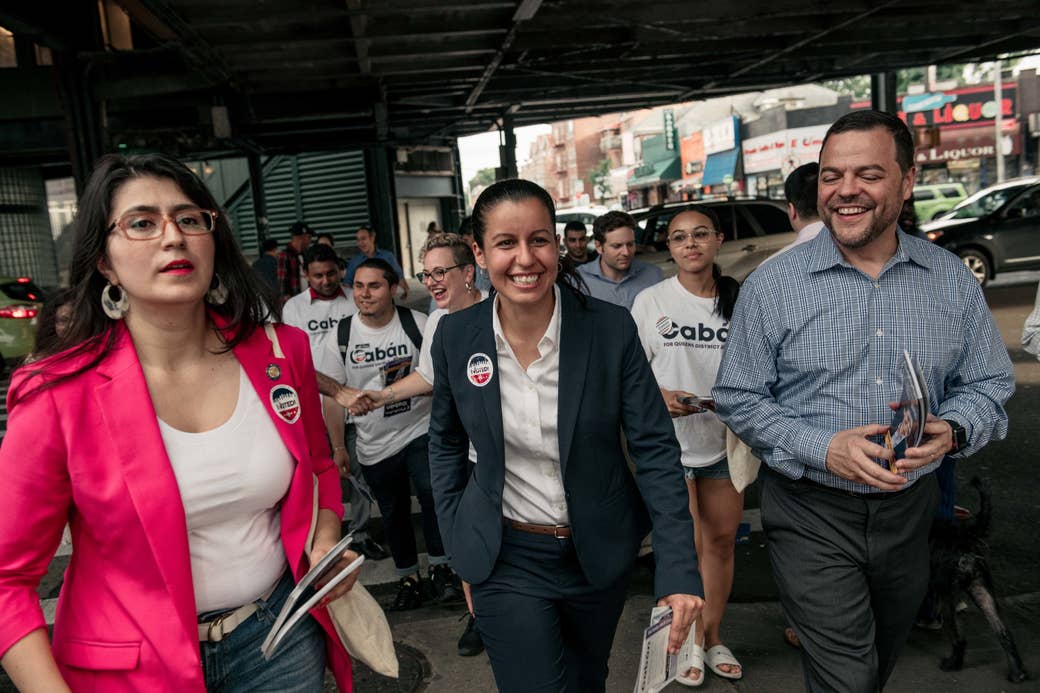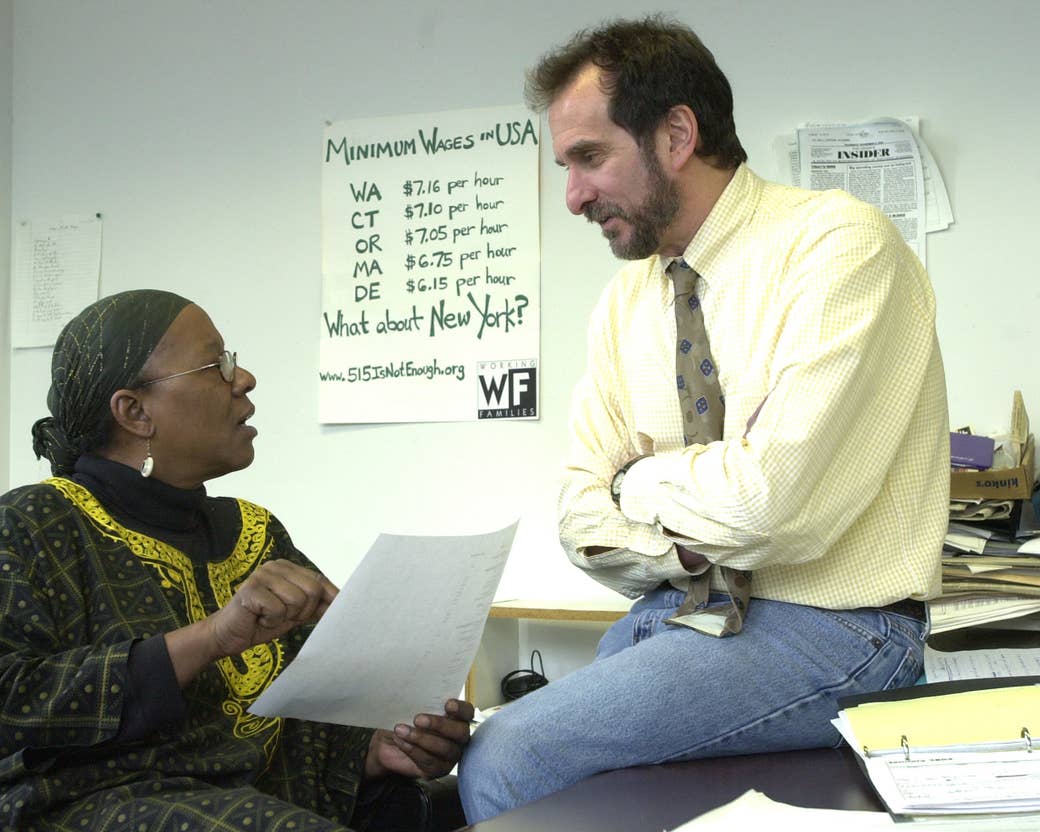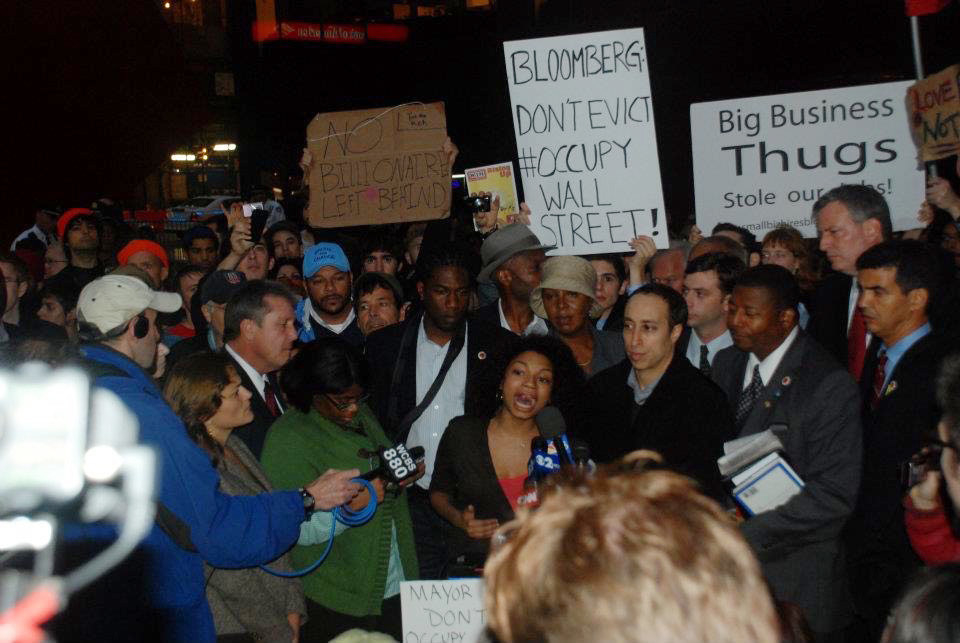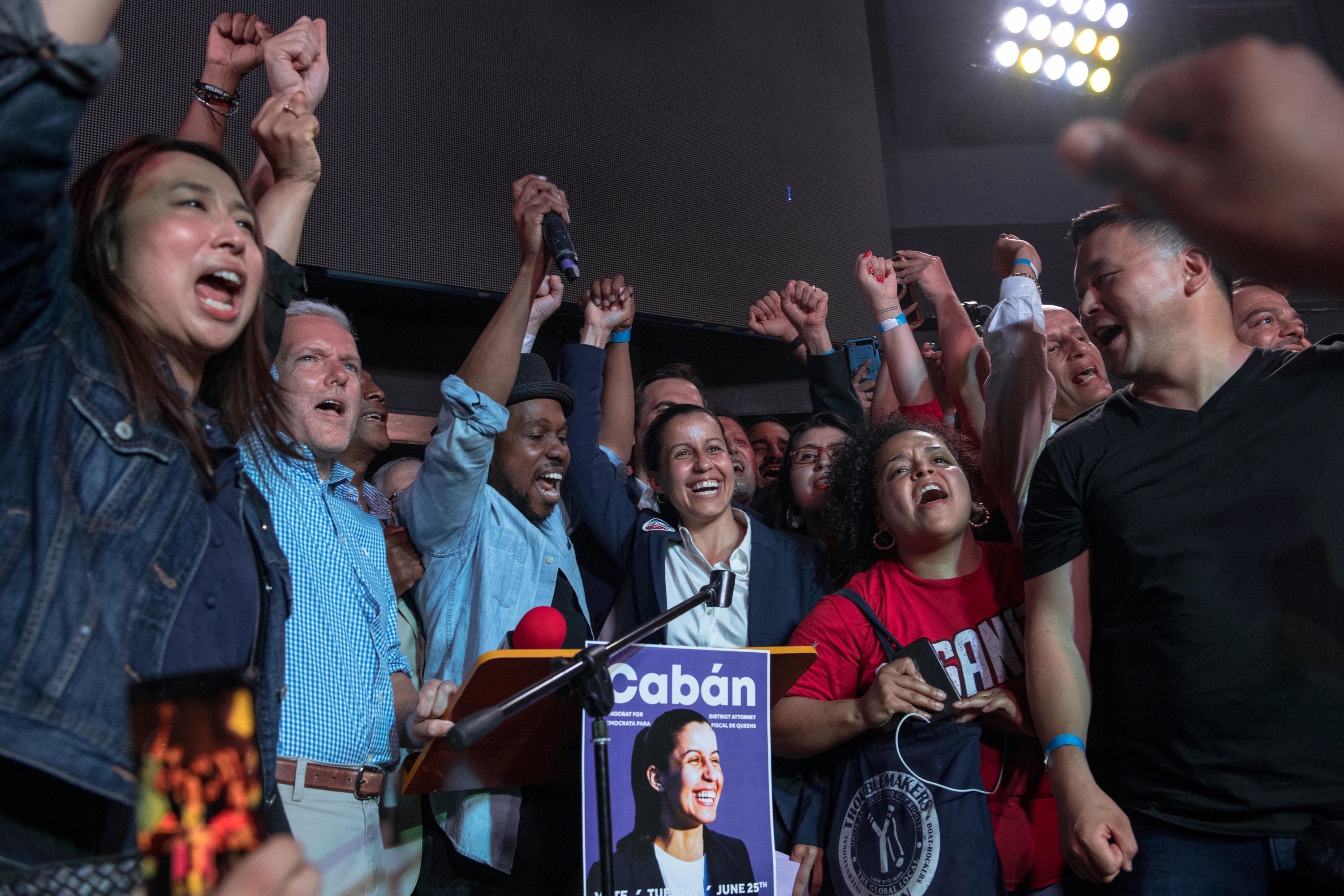
They moved the victory party for Tiffany Cabán to a big nightclub — La Boom — to accommodate the growing crowd on primary night last summer, and the place was packed for the queer, progressive thirtysomething public defender who suddenly had a real shot at being the Queens district attorney.
A lineup of local officials spoke onstage, then an organizer from the Democratic Socialists of America, which had provided hundreds of devoted volunteers. The organizer led the crowd in a booming chant of “DSA, DSA.”
Finally, in the place of honor, introducing Cabán herself, was Bill Lipton, the lean, impatient state director of the Working Families Party, which had professionalized and managed the campaign, bringing it to the brink of victory.
He tried starting a chant too: “I say ‘Working,’ you say ‘Families.’ Working...Families.”
It went a couple of rounds, and then the crowd returned to “DSA, DSA.”
Cabán declared victory on primary night, and then lost when absentee ballots were counted. And WFP — a complicated, powerful force in New York for two decades — now also finds itself at what could be a moment of real triumph, or total irrelevance.
People outside the insular power politics of New York, Philadelphia, and Hartford may not have heard of WFP. But the party has achieved a remarkable amount in America’s biggest city and a key state, where the tax-the-rich economic left is tightening its grip on power. Through the long neoliberal winter of the 1990s and 2000s, WFP played a central role in a series of early progressive victories, bringing paid leave, a millionaire’s tax, softer drug laws, and a higher minimum wage to New York. It was central to flipping the New York State Senate, bringing — among other things — an ambitious Green New Deal to the state.
Now, at what feels like a new national era of progressivism, the party faces deep questions about its future, challenged from both ends by angry Democratic insiders and the new world of movement politics. Among its vulnerabilities is that, as the biggest progressive party in New York, it failed to endorse Rep. Alexandria Ocasio-Cortez when she challenged a machine politician. The party is scrambling to remake itself to the intersectional standards of contemporary progressive politics. And it’s barely survived an assault by Gov. Andrew Cuomo, the master of the state’s machine.
“It’s both satisfying and ironic — at this moment of great triumph in New York, we are facing our own death,” the party’s national chair and former longtime executive director, Dan Cantor, told me outside a grim hearing room in lower Manhattan while his project of 20 years hung in the hands of Cuomo’s allies on an obscure commission. The body had been established to push through progressive campaign finance reforms — but planned, in passing, to put in place new rules making it harder for minor parties to operate. Cantor, like many of the two dozen key figures in the party’s 20 years whom I talked to for this story, was in a nostalgic mood.
“We changed the weather and we got some shit done,” he said.

Most states don’t have third parties that drive their politics. New York is different. Under an obscure bit of state law that permits “fusion voting” third parties have long been able to offer their endorsements to major-party candidates. So the Liberal Party would back Democrats who aligned with what was initially a reformist, progressive, anti-communist strain, the Conservative Party would coendorse anti-abortion Republicans, and so on. Today, WFP is the most powerful of them, alternating between an ally to Democrats and a left-wing irritant that is occasionally strong enough to run its own candidates against Democratic moderates.
But those old insider maneuverings have become unfashionable in this moment of progressive movement politics. And WFP’s response to the moment casts a light on the underreported history of the left in the US — one that points not to Bill Clinton or even Barack Obama, but to AOC, Elizabeth Warren, and Bernie Sanders. In that history, the pressing question is whether the new left can lock in its gains as policy — the way, say, Black Lives Matter helped produce substantive changes to the criminal justice system — or let them mostly slip away, as Occupy Wall Street seemed to.
WFP is the rare, robust leftist institution to survive the ’90s and aughts. Its ascendancy has unlikely roots in a series of mostly doomed and quixotic projects of which the most ambitious — and most doomed — was WFP’s precursor, the New Party.
In the early 1990s, the New Party attempted to provide a new home for the Democratic left — the labor movement, the civil rights movement, the Naderite consumer movement — who had been shoved to the side in Bill Clinton’s Democratic Party. Now they were seeking, if not a true alternative, at least a counterweight to pull the party back their way:
The party was the dream of a brilliant and cantankerous political scientist in Wisconsin named Joel Rogers. As he told me over a morning cigarette in a recent Skype conversation, his idea was that if “you want to fix the society, fix the democracy first.”
He had met Cantor, a "wonderfully honest, decent, tortured, funny guy" from Long Island in the anti-Reagan politics of the 1980s, through an obscure book project of the intellectual left — a tome on "labor, the world economy, and Central America” that Rogers had retained Cantor to write. After Cantor left Jesse Jackson’s campaign for president, the two got to work on a 24,674-word memo called “Party Time.”
The memo made the case for a new political party organized around the “empowerment of working people.” Its backbone would of necessity be the strongest element of the Democratic coalition: organized labor. Its base would be New York, thanks to fusion.
The party would position itself as “progressive” against both Democrats and liberals as follows:
By "progressive" we also mean something other than "liberal," though we recognize overlapping commitments and shared values. Both liberals and progressives, for example, agree that affirmative government action (e.g., regulation, redistribution, education) is required to meet even minimal conditions of democracy. Both (sometimes joined by "honest conservatives") also favor "good government" and "honest government." They hold government to high standards of effective performance, and don't like public fraud and lies. Where progressives and liberals disagree is in their view of working people. In a nutshell, liberals don't believe working people have much capacity to govern their own affairs.
Progressives have much more confidence, and that confidence fuels their democratic conviction. They believe in empowering working people, not just administering them in "kinder, gentler" ways. They believe that a society that encourages and harnesses the capacities of all people, including those of ordinary means, will be both morally superior to and better functioning than one that does not. This strengthens their commitment to democracy.
Cantor mailed hundreds of copies — a radical Unitarian Universalist church on Long Island, gave him access to a Xerox machine — to everyone he could think of. He sent “Party Time” to labor leaders, Democratic politicians, civil rights leaders, and the broad left coalition that had given Jesse Jackson far more juice than the Democratic Party’s establishment had suggested.
The idea was compelling, but the New Party quickly hit an obvious institutional barrier: pulling the Democratic Party to the left threatened Democrats. Rogers and Cantor had hoped to launch the New Party into David Dinkins’ historic run for mayor of New York, itself an echo of the Jackson campaign. But Dinkins’ guru, the late Bill Lynch, killed the idea of him running on the New Party line as well as the Democratic Party’s — according to various recollections, either to avoid seeming too far left or out of fear of getting crosswise with the tight relationship between organized labor and the Democratic Party machine.
“Labor is innately a very conservative set of institutions because they [have] real responsibility to their members,” said Rogers of that disappointment. “They don't ever want to overthrow the established powers that enable them to do that.”
So the New Party started small, allying itself with the well-organized, resolutely outsider community group ACORN in places like Chicago, New Orleans, and Little Rock and with unions in Wisconsin and other Midwestern states. And then, as Rogers had always planned, the party sued, arguing that the Constitution requires states to allow fusion — that is, having two parties run the same candidate. On April 28, 1997, the US Supreme Court ruled 6–3 that the state interest in “reduc[ing] election- and campaign-related disorder” allowed it to ban the practice. It was a crushing defeat and effectively ended the party. Rogers, still angry 20 years later, waved his cigarette and declined to discuss his profane opinions on the decision and the justices on the record.

As the New Party was collapsing, a handful of men had begun having breakfast at a diner on John Street in lower Manhattan. The group members, which included wiry white guys and burly white guys, were the leaders of New York’s radical, old labor left, the dying strand of American politics that came out of Irish, Italian, Jewish immigrant struggles, including the leader of the bus drivers union, Larry Hanley, and the head of ACORN, Jon Kest. They’d coalesced around Sal Albanese, a doomed nominee in the city’s 1997 mayoral race — the candidate of the left-wing white working class, who came in third in the Democratic primary to a white liberal and a black civil rights leader.
His supporters concluded, recalled Bob Master, a longtime political leader with the Communications Workers of America, that Democrats were going to lose the 1998 governor’s race. But there was a little technicality about the statewide contest that interested the group: Just 50,000 votes could provide a new party with a ballot line.
“If we’re going to lose the election in 1998, why don’t we try to take advantage of it and take the ballot line?” Master recalled of his breakfasts with the Albanese crew. Meanwhile, Cantor and Lipton, who were both then trying to figure out what to do with the rubble of the New Party where they’d both worked, were thinking along the same lines, and the two groups began building WFP.
It was the height of Clinton’s Third Way governance and of Rudy Giuliani’s popularity in New York. All they needed was a candidate. In an early mark of the kind of compromise that both made and threatened the party, they settled on an uninspiring city council leader, Peter Vallone — a hero to New York’s aging Greek community but an unlikely champion for the multiracial working people’s party of their dreams.
"For the most part, Vallone's politics represented the antithesis of what we hoped to build — and we took an enormous amount of shit from a lot of activists about that contradiction in ’98,” Master recalled. “But the tactic worked.”
They rallied the support of private-sector unions — CWA and the autoworkers, who didn’t fear the reprisals of elected officials — and of progressive groups who had been boxed in by the pro-business consensus of Democrats like Clinton and moderate Republicans like then-governor George Pataki.
“It did feel like we couldn’t win unless something fundamentally changed,” recalled Karen Scharff, the executive director of Citizen Action, a key early element of WFP.
And then…things actually worked the way the memo from Rogers and Cantor predicted, though for a different party.
WFP raised money from labor unions that were restless with the Democrats’ rightward shift. WFP hired political operatives and got to work in the local races where the Democratic machine had rusted away. The party was central to electing a new left-wing cadre to the city council in 2001 with candidates that included current mayor Bill de Blasio. WFP elected its first candidate on its own line in 2003 — Letitia James, the current New York state attorney general.
And it moved the needle on policy, pushing minimum wage and “living wage” laws. It did in 2004 what became a central progressive cause only 15 years later: It unseated the Democratic district attorney in Albany in a display of muscle that promptly led to the repeal of the state’s punitive Rockefeller Drug Laws.
WFP also made enemies. “I have been turned off by how transactional they have been — not just in my case but in many other instances as well,” one politician told reporter Ross Barkan for his excellent recent history of the party.
In 2009, the party briefly achieved its real goal: a takeover of the New York State Senate, a body long run by moderate Republicans, and pushed through $5 billion in new taxes on the rich. WFP ran the table in New York City, where local legislators pushed through paid sick days over Michael Bloomberg’s opposition, and began the campaign against stop-and-frisk.
The pendulum swung back fast and hard after Barack Obama’s election. Eliot Spitzer, the combative, progressive governor, lost his job in a prostitution scandal. Republicans steamrolled his ineffectual replacement as governor, retook the Senate with the help of Democratic turncoats, and rolled back the left-wing turn.
The party’s style — idealistic policy and very practical politics — became the subject of a federal investigation. It had been operating a kind of internal political consulting firm for candidates it favored; prosecutors accused it of evading campaign finance limits by giving the candidates it supported deep discounts — effectively, a way of laundering labor union money into local campaigns. The party avoided charges, but it was a near-death experience, since it paid its adversaries’ legal fees and shut down the for-profit workaround.
To WFP leaders, the assault was also a sign that they had challenged the system and made powerful enemies. To their critics in Democratic politics, it was something else: evidence that they were running their own cynical machine, doing more or less the same thing that Democrats had done forever while seizing the moral high ground.
“The WFP has engaged in real power politics for a really long time,” said Mike Boland, the party’s field director who left in disgust over its 2014 endorsement of Andrew Cuomo and then returned. “It’s this progressive powerhouse that’s supposed to do amazing progressive things — and because it embraces real power, we’ve had to do some things that make people question the organization.”

But the beginning of the party’s current moment — and ours — began Sept. 17, 2011, when a loose group of protesters settled in a grim little park in the shadows of Wall Street’s towers. They had no real connections to the existing political establishment, and a philosophical stance that excluded making those connections. The official rule was that any politician wishing to deal with protesters would have to appear on site and speak through the cumbersome “human microphone,” characterized by endless choruses of “mic check.” It was a powerful demonstration of organizational principle, and it puzzled and repelled many of Occupy’s allies.
Behind the scenes, WFP helped keep the square occupied. The protesters happened to include one of the party’s rising stars, Nelini Stamp, then 24. A New York kid who couldn't afford college and was helping her mother with health care, Stamp was working retail and raging against the system that had kicked her aside. The Obama campaign, and then WFP’s successful minimum wage campaign, had awakened her to the power of politics.
She called in sick from her job running the party’s Westchester operation. The party kept paying her, and she persuaded her Occupy brethren that she and two other WFP staffers weren’t there in an official capacity.
"Just because you were in the park didn't mean you could negotiate on behalf of the park,” she recalled. She emerged as a key force in the leaderless movement, organizing rallies and setting tactics in the park.
But when they needed political support, she’d called New York Communities for Change's Kest, a key WFP figure, and Lipton, the state director.
“I’d tell Bill or Jon what we needed, and they would call an elected [official],” she recalled — rallying food and political support. The party negotiated with Mike Bloomberg’s city hall, brought labor unions around to seeing the scruffy protesters as their allies, and at one point called elected officials to the park to stave off attempts to clear it out. It was a little-known bit of practical politics in a movement now famous both for its symbolic success and organizational failures.
“People really overlook the importance of the party in the movement,” she said.
Occupy was, in retrospect, the birthplace of our current moment. It energized the American left, but the lack of a sustainable movement — or established interests that incorporated that energy and outlook — created a void that has now been filled by true outsiders like Bernie Sanders.
And Alexandria Ocasio-Cortez.
By 2018, WFP and its labor union allies had long had a warm relationship with the boss of the Queens Democratic machine, a genial Irish American political operator named Joe Crowley. Crowley had been a powerful, useful ally in Washington. The party was at war with incumbents across the state, doing their best to defend an embattled and controversial socialist in Brooklyn, and focused on seizing control of the levers of power in Albany. Nobody had much time for the young bartender running against Crowley.
“Nobody knows who the fuck this person is, and we’re about to go against Andrew Cuomo,” recalled a labor union official involved in the choice of Crowley over Ocasio-Cortez. “Anyway, how many enemies can you survive?”
It was a signal mistake. And it embodied the party’s two key weaknesses in this era of clear talk, a new kind of communications, and a deep distrust for that inside game.
One is WFP’s pragmatism, its willingness to dirty its hands with compromise and power politics — something that its leaders see as a key feature, not a bug.
But, secondly, the failure to endorse the breakout millennial political star also embodied the party’s long-standing blind spot. From those early days in the diner on John Street and in Rogers’ Madison office, the party was built by an older and whiter generation of progressive leaders who have begun to fade into the background as the American left became intensely focused on questions of representation. There had been black and Latino labor figures close to the party from the start, many hailing from the powerful SEIU local 1199 and ACORN. The organization’s constituents and its intended beneficiaries were mostly black and Latino, and figures like Dinkins, Patrick Gaspard, and Harry Belafonte had been around at its birth.
But its founders and early leaders, like ACORN’s, were white leftists, and that contrast was always obvious on the inside.
When Bertha Lewis, a black woman who got her start as a housing organizer in the Bronx, had first walked into the party’s office in Brooklyn, she said, the collection of white people “would burn your retinas out.”
Lewis, who would play a central role in the politics of the Bloomberg years before leading ACORN in its final days, always dreamed that WFP would ultimately follow what she saw as its central logic and become a “black people’s party.”
And perhaps it will. Cantor, who stepped down in 2018, told me he hopes the party’s founders will be remembered as having “had the skill to build something real, and the grace to hand it over to an of-color leader who has similar politics but a very different background, and will take the org[anization] places that the founders never could.”

When I ran into Maurice Mitchell on the floor of the ill-fated Cabán victory party, I didn’t realize that he was in charge of WFP. A 40-year-old black guy from Long Island with a fedora and an easy smile, he’d be easy to mistake for, say, the frontman for an Afropunk band…which he also is.
But when the party went looking for a new generation of leaders after the 2018 midterms, Dan Cantor, Bill Lipton, and their allies realized they needed to transform themselves for the moment: to hand the reins to people who better represented the politics they were fighting for. And, perhaps more important, it was time to try to turn a party that had mostly been a political organization into something more like a movement.
Mitchell was the answer. A product of a corner of multiracial working-class life in central Long Island, he grew up steeped in the radical traditions of Caribbean politics. He was, for a time, the lead singer of a mostly white punk band, though the band’s composition has grown more diverse with time. And he was a political activist since his school days, working in a series of unglamorous local organizing jobs on Long Island before a black man’s shooting in Ferguson, Missouri, triggered the Black Lives Matter movement.
Mitchell moved to Ferguson and lived in the attic of an older white anti–death penalty activist. He wound up living there for five months and cofounding a collective called Blackbird, a communications and strategy arm of the movement. He was, he thinks, the “riskiest” candidate to take over WFP, and he warned the men hiring him that he wasn’t joking about transformation. From an idea that “really lived in a small core of people” to “a multiracial movement that spans the country.”
The world has changed, but the goal isn’t that different from what Rogers and Cantor envisioned two decades earlier. The objective, Mitchell said, is to “build a multiracial left movement that would be a united front that would unite the black radicals and the white liberals against the forces of evil.”
Mitchell, who is now the national director of WFP (it is, at this point, an overlapping web of more than a dozen national and state committees), has been greeted with an enthusiasm blended with skepticism about whether WFP can transform itself from a local political operation into a national movement. (One veteran called the very notion of turning WFP into a real party “bullshit.”)
He has already shown one key quality: the willingness to play power politics. The party infuriated some of its members, and inspired others, by endorsing Elizabeth Warren in September 2019 and then refusing to release the details of an internal endorsement process. It’s the sort of move that makes the party a sought-after endorsement, and it looked for a time like a bold path to power in a Warren administration. Less than a few months later, the risk of crossing Sanders and supporters who include, again, Ocasio-Cortez seems starker.
The party’s friends and enemies alike aren’t sure if it’ll be able to make the transition. And this is part of the wide-open question of what comes out of this new era of energy on the left: Will there be strong new institutions, or revived old ones, with new progressive political bosses? Will the tide recede to leave figures like Cuomo, the New York governor who has done just enough to keep progressive voters on his side without ever letting the left wing of his party build lasting power?
Now, Mitchell is trying to blend the movement strategies of the new world with the imperatives of practical politics, and even the cantankerous Rogers said he was impressed.
“Maurice is much more a [social justice warrior] type than [Cantor is], but Maurice certainly knows that elections matter and takes very seriously the organization and organizing discipline needed to make a difference in them, and after,” he said.
Mitchell’s view of his mission: “I’m trying to corner the market on nondelusional third-party politics.” ●
